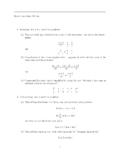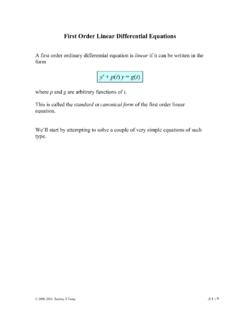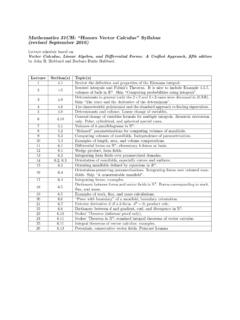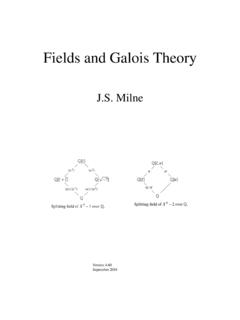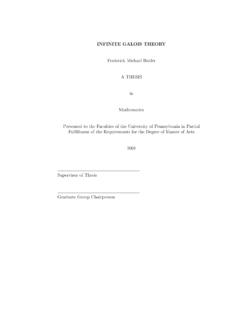Transcription of The Fundamental Theorem of Galois Theory
1 Fundamental Theorem of Galois TheoryTheorem (The Fundamental Theorem of Galois Theory ).LetL/Kbe a finite Galois extension. Then there is an inclusion reversingbijection between the subgroups of the Galois groupGal(L/K)and in-termediary subfieldsL/M/K. Given a subgroupH, letM=LHandgiven an intermediary fieldL/M/K, letH= Gal(L/M). will be an easy consequence of all that has gone that we are given a subgroupHofG. LetM=LHandthen setK= Gal(L/M). We want to show thatK=H. As we havealready proved thatH K,and|G|= [L:K] is finite, it suffices to prove that the cardinality ofKand is at most the cardinality ofH.
2 But|H|= [L:M],and there are at most [L:M] automorphisms ofL/M, so that|K| [L:M] =|H|.ThusH=K, and the composition one way is the suppose that we start withL/M/K. LetH= Gal(L/M) andletN=LH. We already know thatM N,and so by the Tower Law it suffices to prove that[L:N] [L:M].AsL/Kis Galois , then so isL/M. But then[L:M] =|H|.AsHis a set of automorphisms ofL/N, we have[L:N] |H|= [L:M].ThusM=Nand the composition the other way is the identity. Thuswe have a correspondence. We have already seen that this correspon-dence is inclusion reversing. The rest of the course will be adressed to deriving consequences ofthe Fundamental Theorem .
3 We start by observing, Theorem (Primitive Element Theorem ).LetL/Kbe a finiteseparable suffices to prove that there are only finitely many intermediaryfields. To this end, we are certainly free to enlargeL. ReplacingLbyits normal closure, we may as well assume thatL/Kis Galois . In thiscase the Galois groupGis finite and so there are clearly only finitelymany subgroups ofG. But by the Galois correspondence there are thenonly finitely many intermediary fields. It is traditional in the statement of the Fundamental Theorem tocharacterise whenM/Kis normal in terms of the associated (The Fundamental Theorem of Galois Theory : bis).
4 LetL/Kbe a finite Galois extension. Then there is an inclusion re-versing bijection between the subgroups of the Galois groupGal(L/K)and intermediary subfieldsL/M/K. Given a subgroupH, letM=LHand given an intermediary fieldL/M/K, letH= Gal(L/M).FurthermoreM/Kis normal if and only ifHis normal inG. Inthis case the Galois group ofM/Kis isomorphic have already established the existence of the thatM/Kis normal if and only if for every G, (M) Mif and only if (M) =M. Suppose thatM/Kis normal. Define a mapf:G Gal(M/K),by sending to the restriction of toM. AsM/Kis normal, is indeed an automorphism ofM/K.
5 It is easy to check thatfis ahomomorphism of groups. ClearlyHis the kernel, so thatHis indeednormal. It follows thatG/His isomorphic to a subgroup of Gal(M/K).But|Gal(M/K)|= [M:K]=|L:K]/[L:M]=|G|/|H|,where we used the Tower Law and the fact thatL/MandL/KareGalois extensions, so that in fact Gal(M/K)' suppose thatHis normal. Suppose thatm Mand let (m). AsHstabilisesm, thenH= H , by the correspondence already established, the only elements ofLstabilised by all ofH, are in fact elements ofM. Thusn M, and (M) M. But thenM/Kis normal. We now turn to the problem of computing Galois groups, in explicitcases.
6 It turns out that this is a relatively straightforward Galois (indeed it is quadratic) and the Galois grouphas order (i).iis a root ofx2+ 1, irreducible, and anyautomorphism ofL/Kmust sendito another root. There are onlytwo possible roots, i. One gives the identity, the other is for any other quadratic compute the Galois group ofx4 2overK= this we mean we look at the splitting fieldL/Kofx4 2 andcompute this Galois group. We first start by computing the splittingfield. First we need to attach a fourth root of 2. Suppose that we callthis . We getM=K( ) and asx4 2 is irreducible this is a degreefour extension.
7 Then we add a primitive fourth root of 1. Call thisi, sothati2= 1. We can always pick so that it is real. Theni / M, sothatL/Mis a degree two extension. Thus, by the Tower law, we havea degree eight extension. NowL/Kis Galois , asx4 2 is separable(characteristic zero).Thus|G|= 8. We look for generators and relations. First considerthe extensionL=M(i)/M. This has order two, and so there is anautomorphism fixingM(that is fixing ) which switchesiand one automorphism ofL/Kis given by , where the action of on generators is ( ) = and (i) = note that there is an automorphism ofL/Kwhich sends to any other root, in particulari.
8 Now need not fixi. If it doesnot, then fixesiand sends to i . But then the cube send toi . Thus we may assume ( ) =i and (i) = 4= 1 and 2= 1. In particular and generate two sub-groups ofG, of order four and two. It follows that and are genera-tors ofG. What are the relations? It suffices to compute the conjugateof by , . This sendsitoiand to i . Thus 1= presentationGenerators: and .Relations: 4= 2=e, 1= recognise this asD4, the Dihedral group of order eight, the sym-metries of the square. In fact we can even see the square. The actionofGis determined by its action on the four roots and i , whichare arranged in a square on the argand we list all the possible subgroups and intermediate fields.
9 Wehave already computed all possible subgroups ofD4. LetHbe a sub-group. Then the order ofHdivides the order ofG, so that the orderofHis 1, 2, 4 or 8. The cases 1 and 8 are easy and obvious, the trivialsubgroup and the whole that the order ofHis two. ThenHis generated by anelement of order two. There are five of these, the two diagonal flips,the two side flips, and rotation by 180 . ThusHis one of , 2 , , 3 , 2 .Now suppose that the order ofHis four. One possibility is .Otherwise we have to combine two elements of order two note that any subgroup ofGof order 4 has index 2 and anysubgroup of index two is normal.
10 Thus ifHis a subgroup of order 4then it is normal inG. But a subgroupHofGis normal if and only ifit is a union of conjugacy classes. Now the diagonal flips and the sideflips are conjugates of each other, so we can combine two side flips, ortwo diagonal flips, but we cannot mix side and diagonal flips. Thus thesubgroups of order 4 are , , 2 , , 2 .Now we list the corresponding fixed fields. Two extremes areQandQ( ,i), corresponding toGand{e}. IfM/Qis quadratic thenthe corresponding subgroupHhas order 4 and index 2. Thus we arelooking for three subfields of degree two,Q(i),Q( 2),Q(i 2).




